Experimental Study of Black Cotton Soil Stabilization with Natural Lime and Pozzolans in Pavement Subgrade Construction
Abstract
:1. Introduction
2. Materials
2.1. Black Cotton Soils (BCS)
2.2. Volcanic Ash
2.3. Hydrated Lime
3. Methods
3.1. Combination Scheme and Sample Preparation
3.2. Engineering Properties Measurements
3.3. Assessment of Plasticity
3.4. Assessment of Soil Compaction Characteristics
3.5. Assessment of Soil Bearing Strength
3.6. Assessment of Swelling Soil Characteristics
4. Results and Discussion
4.1. Effects of Volcanic Ash and Hydrated Lime on Plasticity
4.2. Effects of Stabilizers on Compaction Characteristics
4.3. Effects of Volcanic Ash and Hydrated Lime on the California Bearing Ratio and Expansion Ratio
5. Conclusions
- BCS stabilized with 3% lime + 20% VA exhibited enhanced mechanical properties such as an increase in the CBR and MDD, which indicated an increase in strength.
- The addition of 3% lime + 20% VA increased the BCS CBR values significantly, by 10.76 folds, reduced the swell potential by 88%, and reduced the plasticity index by 29%, thus meeting the standard requirement for Class S2 and above pavement subgrade materials according to Kenya’s national road design manual.
- This study found that both lime and VA significantly reduced the plasticity of BCS.
- This study found that volcanic ash sourced in Kenya mixed with lime in a 3% lime + 20% VA combination can be used as an effective BCS stabilizer.
Author Contributions
Funding
Institutional Review Board Statement
Informed Consent Statement
Data Availability Statement
Acknowledgments
Conflicts of Interest
References
- Briceño-garmendia, C.M.; Shkaratan, M. Kenya’ s Infrastructure: A Continental Perspective; AASHTO: Washington, DC, USA, 2010. [Google Scholar]
- Njoro, W.M. Impact of Infrastructure Development on Economic Competitiveness in Kenya; Semantic Scholar: Nairobi, Kenya, 2016. [Google Scholar]
- Karatai, T.R.; Kaluli, J.W.; Kabubo, C.; Thiong’O, G. Soil Stabilization Using Rice Husk Ash and Natural Lime as an Alternative to Cutting and Filling in Road Construction. J. Constr. Eng. Manag. 2017, 143, 04016127. [Google Scholar] [CrossRef]
- Kanyanjua, S.M.; Keter, J.K.; Okalebo, R.J.; Verchot, L. Identifying potassium-deficient soils in Kenya by mapping and analysis of selected sites. Soil Sci. 2006, 171, 610–626. [Google Scholar] [CrossRef]
- Ministry of Public Works Kenya. Part III—Materials & Pavement Design.pdf; Ministry of Public Works Kenya: Nairobi, Kenya, 1999.
- Rao, S.; Thyagaraj, T. Swell-compression behaviour of compacted clays under chemical gradients. Can. Geotech. J. 2007, 44, 520–532. [Google Scholar] [CrossRef]
- Zhang, P.; Huang, J.; Shen, Z.; Wang, X.; Luo, F.; Zhang, P.; Wang, J.; Miao, S. Fired hollow clay bricks manufactured from black cotton soils and natural pozzolans in Kenya. Constr. Build. Mater. 2017, 141, 435–441. [Google Scholar] [CrossRef]
- Miao, S.; Shi, J.; Sun, Y.; Zhang, P.; Shen, Z.; Nian, H.; Huang, J.; Wang, X.; Zhang, P. Applied Clay Science Mineral abundances quanti fi cation to reveal the swelling property of the black cotton soil in Kenya. Appl. Clay Sci. 2018, 161, 524–532. [Google Scholar] [CrossRef]
- Tripathy, S.; Rao, K.S.; Fredlund, D.G. Water content—Void ratio swell—Shrink paths of compacted expansive soils. Can. Geotech. J. 2002, 959, 938–959. [Google Scholar] [CrossRef]
- Wang, Z.-F.; Shen, S.-L.; Yin, Z.-Y.; Xu, Y.-S. Rapid field evaluation of the strength of cement-stabilized clayey soil. Bull. Int. Assoc. Eng. Geol. 2014, 74, 991–999. [Google Scholar] [CrossRef]
- Aldaood, A.; Bouasker, M.; Al-Mukhtar, M. Effect of long-term soaking and leaching on the behaviour of lime-stabilised gypseous soil. Int. J. Pavement Eng. 2015, 16, 11–26. [Google Scholar] [CrossRef]
- Yazdandoust, F.; Yasrobi, S.S. Applied Clay Science Effect of cyclic wetting and drying on swelling behavior of polymer-stabilized expansive clays. Appl. Clay Sci. 2010, 50, 461–468. [Google Scholar] [CrossRef]
- Al-Mukhtar, M.; Lasledj, A.; Alcover, J.-F. Applied Clay Science Behaviour and mineralogy changes in lime-treated expansive soil at 20 °C. Appl. Clay Sci. 2010, 50, 191–198. [Google Scholar] [CrossRef]
- Babu, G.L.S.; Vasudevan, A.K.; Sayida, M.K. Use of Coir Fibers for Improving the Engineering Properties of Expansive Soils. J. Nat. Fibers 2008, 5, 61–75. [Google Scholar] [CrossRef]
- Murty, V.R.; Praveen, G.V. Use of Chemically Stabilized Soil as Cushion Material below Light Weight Structures Founded on Expansive Soils. J. Mater. Civ. Eng. 2008, 20, 392–400. [Google Scholar] [CrossRef]
- Nawalany, G.; Sokołowski, P. Building—Soil Thermal Interaction: A Case Study. Energies 2019, 12, 2922. [Google Scholar] [CrossRef] [Green Version]
- Dang, L.C.; Khabbaz, H.; Ni, B.-J. Transportation Geotechnics Improving engineering characteristics of expansive soils using industry waste as a sustainable application for reuse of bagasse ash. Transp. Geotech. 2021, 31, 100637. [Google Scholar] [CrossRef]
- Al-Mukhtar, M.; Lasledj, A.; Alcover, J.-F. Applied Clay Science Behaviour and mineralogy changes in lime-treated expansive soil at 50 °C. Appl. Clay Sci. 2010, 50, 199–203. [Google Scholar] [CrossRef]
- Al-Rawas, A.A.; Hago, A.W.; Al-Sarmi, H. Effect of lime, cement and Sarooj (artificial pozzolan) on the swelling potential of an expansive soil from Oman. Build. Environ. 2005, 40, 681–687. [Google Scholar] [CrossRef]
- Sitepu, F.; Harianto, T.; Ridwan, R.; Marfuah, N. Behaviour of Mixed Expansive Soil and Additive Minerals as Subgrade Layer. IOP Conf. Ser. Earth Environ. Sci. 2021, 841, 012009. [Google Scholar] [CrossRef]
- Mizota, C.; Domon, Y.; Yoshida, N. Oxygen isotope composition of natural phosphates from volcanic ash soils of the Great Rift Valley of Africa and east Java, Indonesia. Geoderma 1992, 53, 111–123. [Google Scholar] [CrossRef]
- Hossain, K.; Mol, L. Some engineering properties of stabilized clayey soils incorporating natural pozzolans and industrial wastes. Constr. Build. Mater. 2011, 25, 3495–3501. [Google Scholar] [CrossRef]
- BS 1377-9:1990; Methods of Test for Soils for Civil Engineering Purposes—Part 2: Classification Tests. British Standard Institutions: London, UK, 2020.
- BS EN ISO 14688-1:2018; BSI Standards Publication Geotechnical Investigation and Testing—Identification and Classification of Soil. British Standards Institutions: London, UK, 2018; Volume 2, pp. pp. 4–6.
- AASHTO. AASHTO-T99-T180 Moisture-Density Relations of Soils; AASHTO: Washington, DC, USA, 2012; Volume 310, pp. 1–12. [Google Scholar]
- Documents, R. The California Bearing Ratio; American Society for Testing and Materials: West Conshohocken, PA, USA, 2003; Volume 99, pp. 1–11. [Google Scholar]
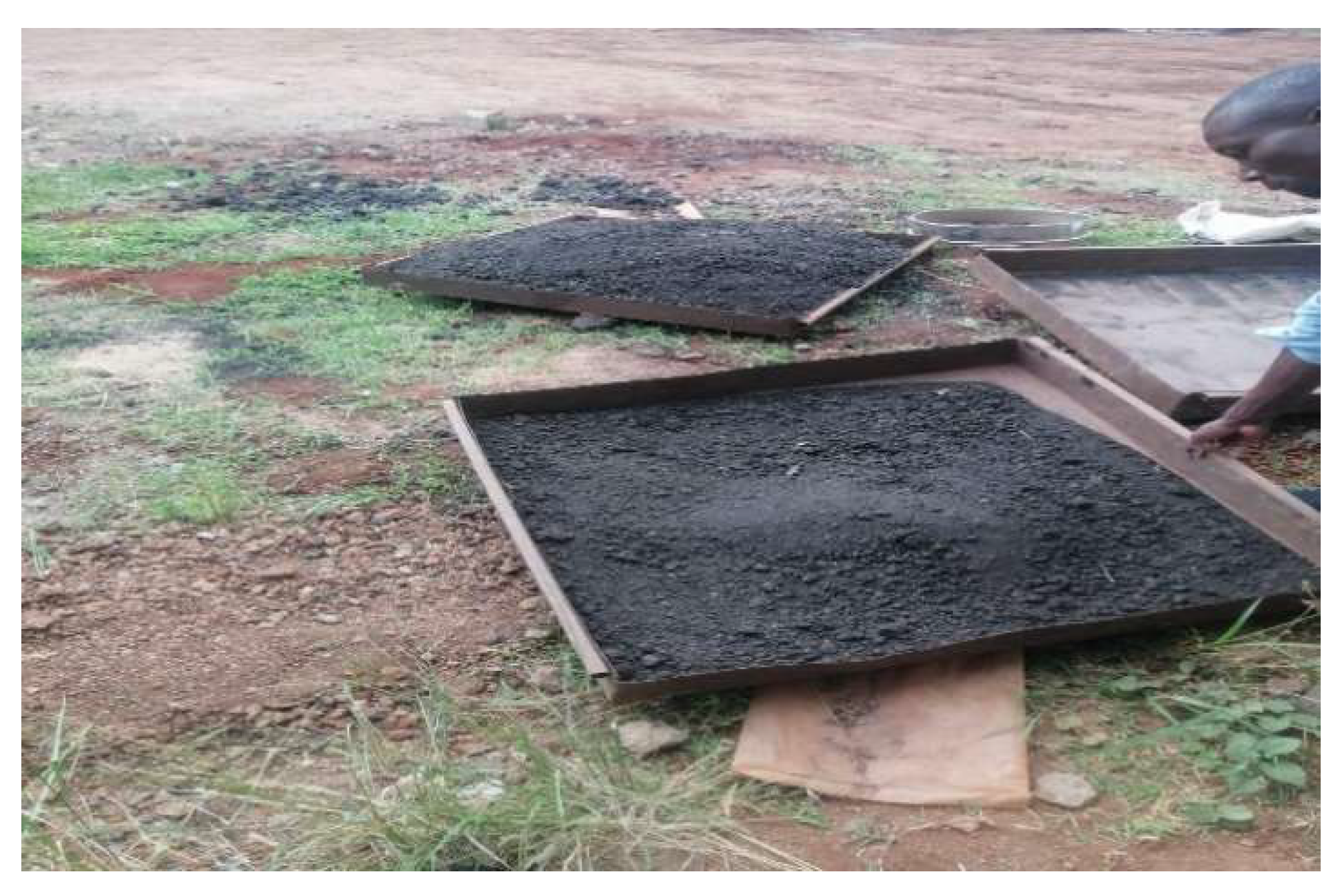
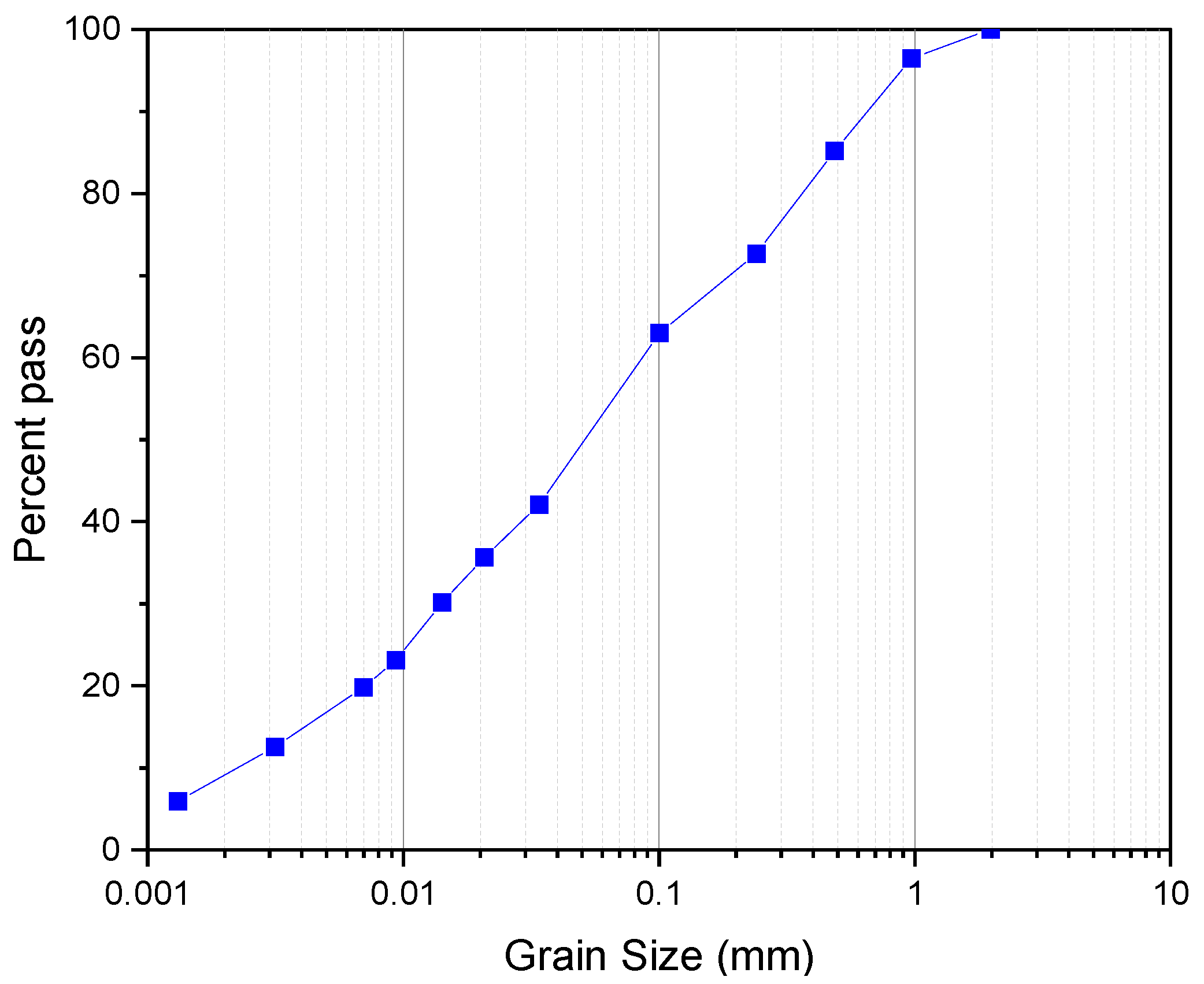
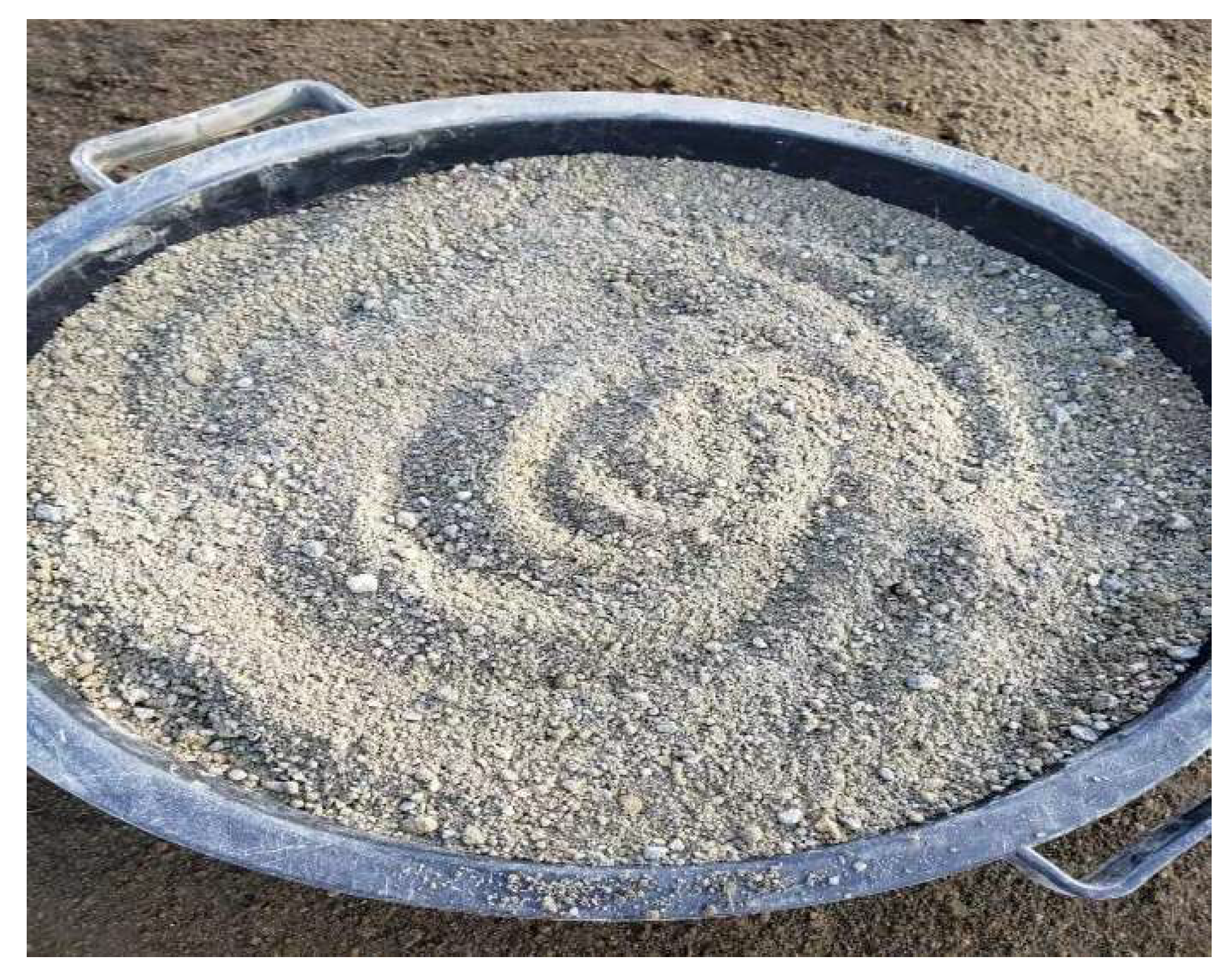
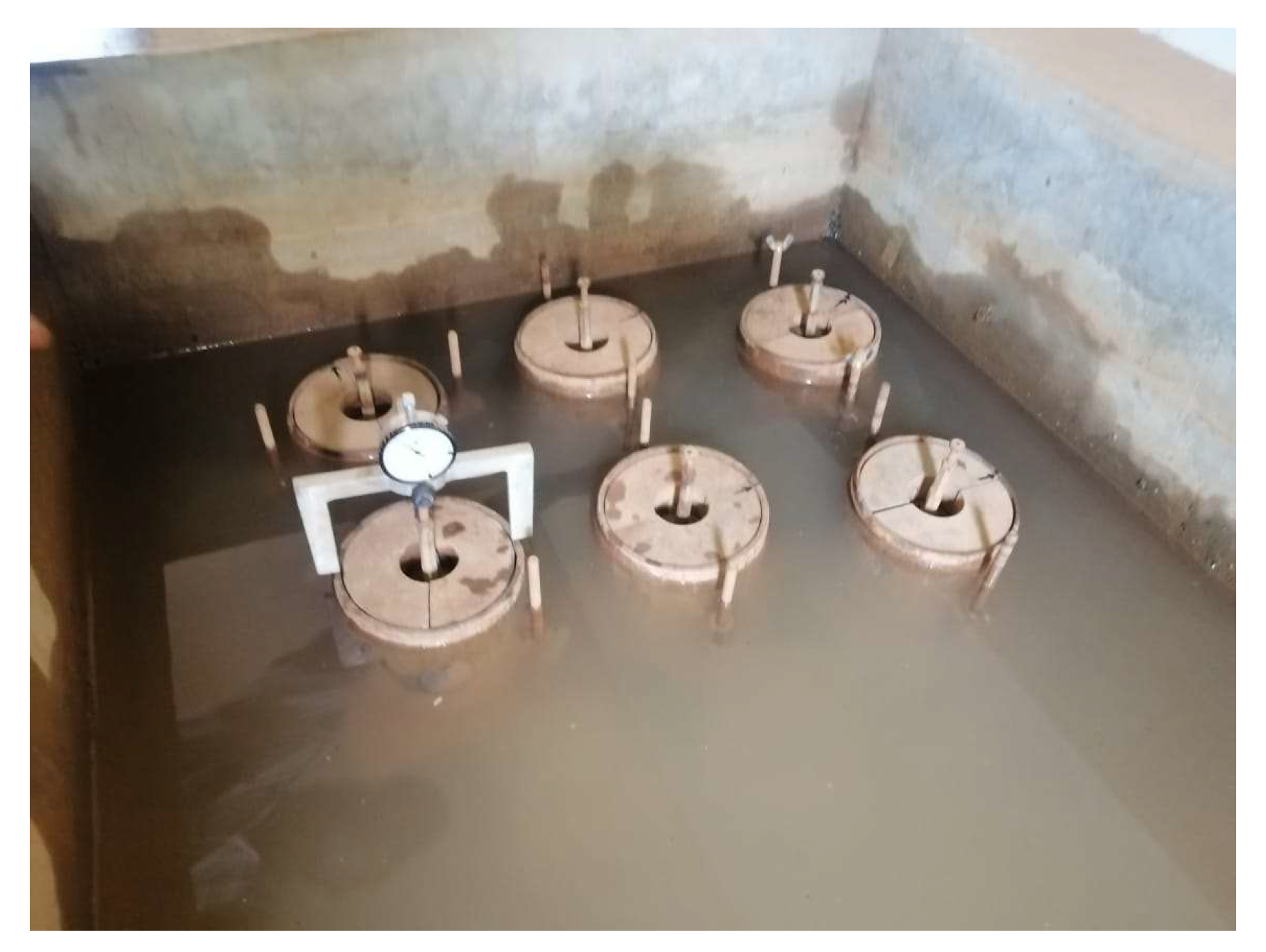
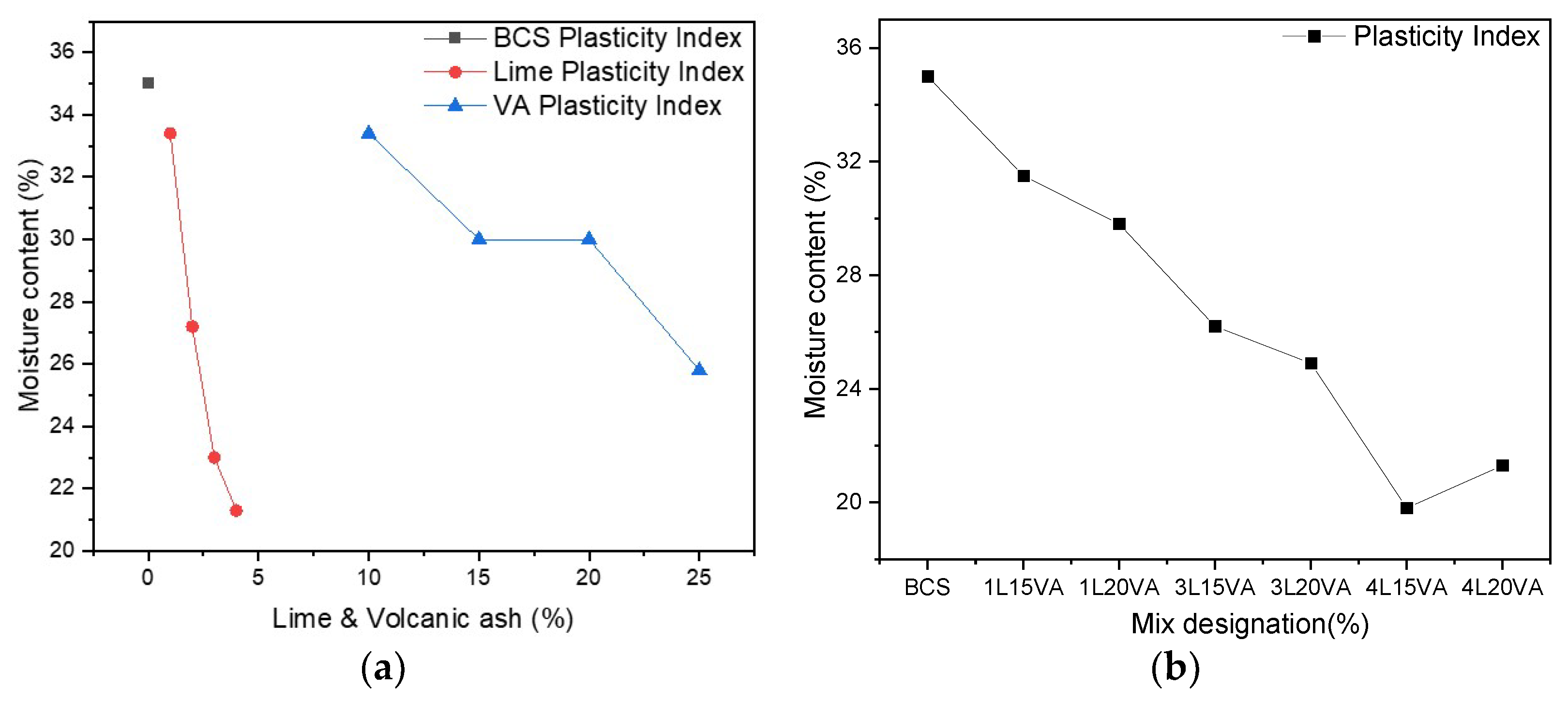
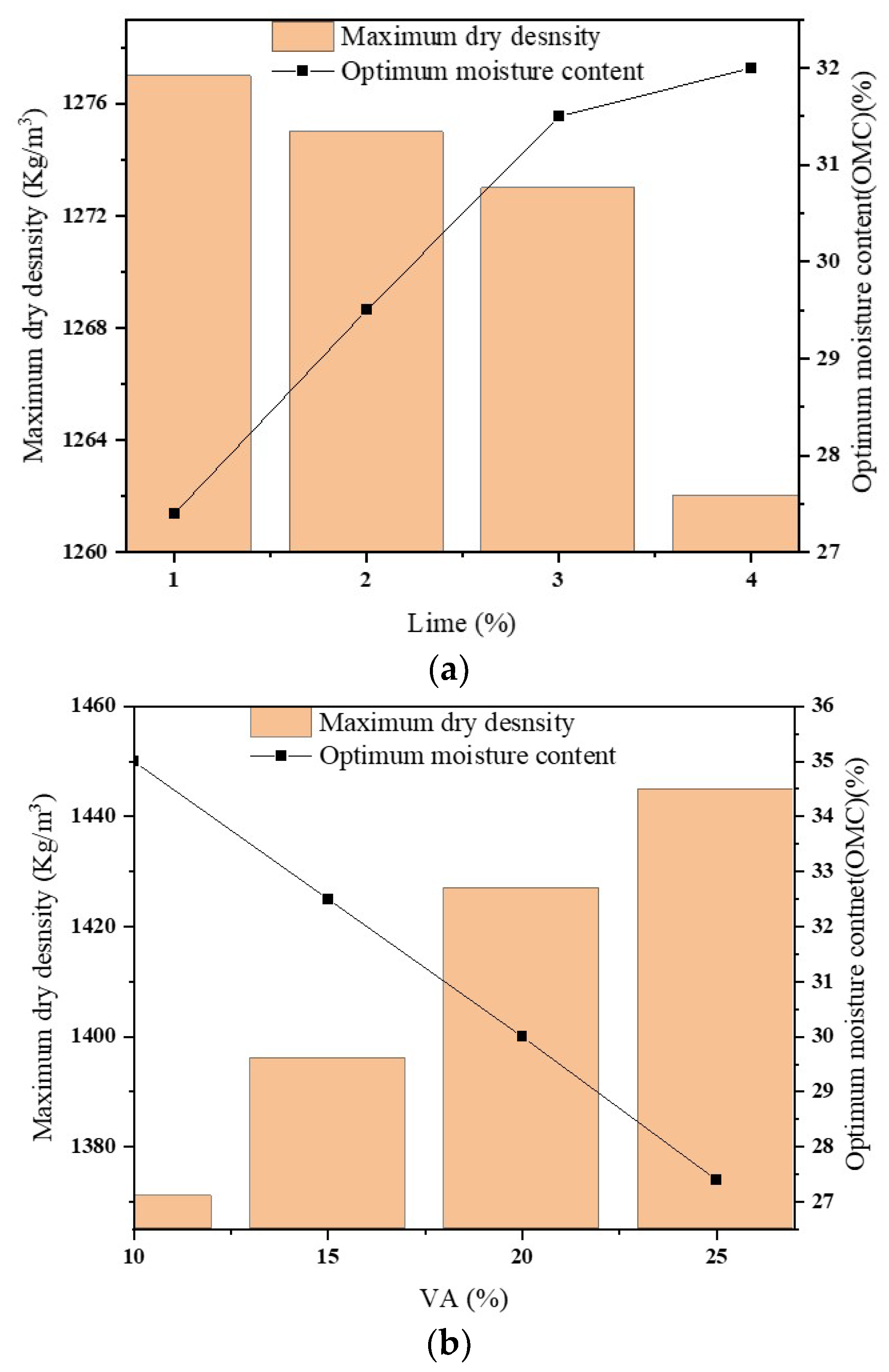
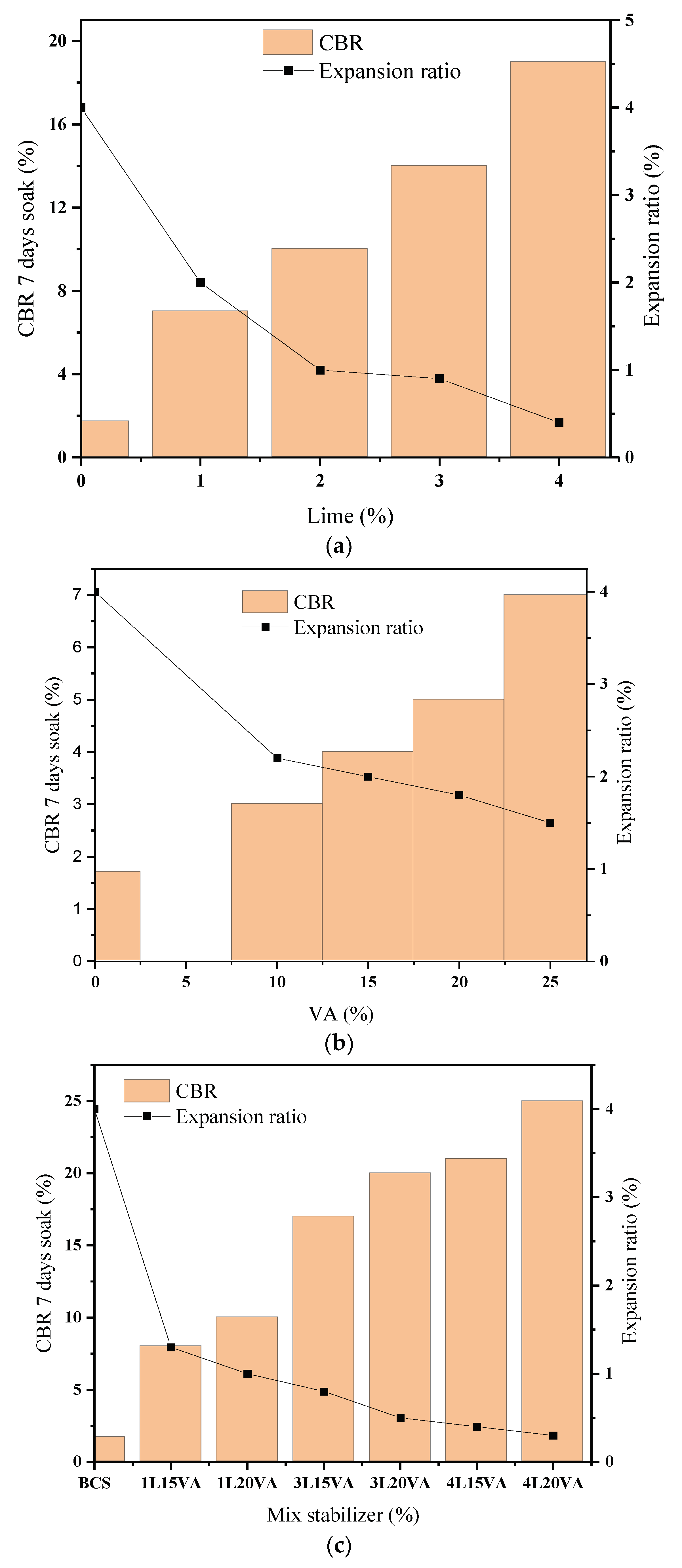
| Properties | Test Values |
|---|---|
| LL (%) | 70.7 |
| PL (%) | 35.7 |
| PI (%) | 35 |
| MDD (g/m3) | 1449 |
| OMC (%) | 34 |
| CBR (%) | 1.7 |
| Linear Shrinkage Limit (%) | 16.4 |
| Free Swell Index (%) | 3 |
| Plastic Modulus (%) | 1680 |
| Grading% passing sieve size 0.425 mm | 48 |
| Properties | Volcanic Ash (VA) | Black Cotton Soil (BCS) |
|---|---|---|
| CaO | 10.26 | 1.68 |
| Fe2O3 | 12.24 | 9.22 |
| MgO | 11.42 | 0.97 |
| K2O | 1.29 | 1.03 |
| SO3 | 0.08 | - |
| MnO | 0.17 | 0.26 |
| AL2O3 | 13.46 | 17.04 |
| Na2O | 2.66 | 0.69 |
| P2O2 | 0.49 | 0.02 |
| TiO2 | 2.63 | 0.91 |
| SiO2 | 43.54 | 50.28 |
| Loss on ignition | 0.46 | 18.02 |
| No. | Volcanic Ash (%) | Hydrated Lime (%) | Mix Ratio VA:L | Total Stabilizer Content (%) | Notes |
|---|---|---|---|---|---|
| 1 | - | - | 0:0 | - | Neat BCS |
| 2 | - | 1 | 0:1 | 1 | - |
| 3 | - | 2 | 0:2 | 2 | - |
| 4 | - | 3 | 0:3 | 3 | Lime and BCS |
| 5 | - | 4 | 0:4 | 4 | - |
| 6 | 10 | - | 10:0 | 10 | - |
| 7 | 15 | - | 15:0 | 15 | VA with BCS |
| 8 | 20 | - | 20:0 | 20 | - |
| 9 | 25 | - | 25:0 | 25 | - |
| 10 | 15 | 1 | 15:1 | 16 | - |
| 11 | 20 | 1 | 20:1 | 21 | VA, lime and BCS |
| 12 | 15 | 3 | 5:1 | 18 | - |
| 13 | 20 | 3 | 20:3 | 23 | - |
| 14 | 15 | 4 | 15:4 | 19 | - |
| 15 | 20 | 4 | 5:1 | 24 | - |
| Sample No. | Samples | Liquid Limit (%) | Plastic Limit (%) |
|---|---|---|---|
| 1 | Neat BCS | 70.7 | 35.7 |
| Lime (%) | |||
| 2 | 1 | 71.3 | 37.9 |
| 3 | 2 | 69.2 | 42 |
| 4 | 3 | 65.8 | 42.8 |
| 5 | 4 | 64.3 | 43 |
| Volcanic ash (%) | |||
| 6 | 10 | 75.4 | 42 |
| 7 | 15 | 65.6 | 35.6 |
| 8 | 20 | 65 | 35 |
| 9 | 25 | 65.8 | 40 |
| Mix stabilizer | |||
| 10 | 15% VA + 1% L | 64.4 | 32.9 |
| 11 | 20% VA + 1% L | 69.5 | 39.7 |
| 12 | 15% VA + 3% L | 58.2 | 32 |
| 13 | 20% VA + 3% L | 56.9 | 32 |
| 14 | 15% VA + 4% L | 53.9 | 33.9 |
| 15 | 20% VA + 4% L | 56.9 | 35.6 |
| Subgrade Class | CBR Range (%) | Median |
|---|---|---|
| S1 | 2–5 | 3.5 |
| S2 | 5–10 | 7.5 |
| S3 | 7–13 | 10 |
| S4 | 10–18 | 14 |
| S5 | 15–30 | 22.5 |
| S6 | >30 | - |
Publisher’s Note: MDPI stays neutral with regard to jurisdictional claims in published maps and institutional affiliations. |
© 2022 by the authors. Licensee MDPI, Basel, Switzerland. This article is an open access article distributed under the terms and conditions of the Creative Commons Attribution (CC BY) license (https://creativecommons.org/licenses/by/4.0/).
Share and Cite
Yin, Z.; Lekalpure, R.L.; Ndiema, K.M. Experimental Study of Black Cotton Soil Stabilization with Natural Lime and Pozzolans in Pavement Subgrade Construction. Coatings 2022, 12, 103. https://doi.org/10.3390/coatings12010103
Yin Z, Lekalpure RL, Ndiema KM. Experimental Study of Black Cotton Soil Stabilization with Natural Lime and Pozzolans in Pavement Subgrade Construction. Coatings. 2022; 12(1):103. https://doi.org/10.3390/coatings12010103
Chicago/Turabian StyleYin, Zihong, Raymond Leiren Lekalpure, and Kevin Maraka Ndiema. 2022. "Experimental Study of Black Cotton Soil Stabilization with Natural Lime and Pozzolans in Pavement Subgrade Construction" Coatings 12, no. 1: 103. https://doi.org/10.3390/coatings12010103
APA StyleYin, Z., Lekalpure, R. L., & Ndiema, K. M. (2022). Experimental Study of Black Cotton Soil Stabilization with Natural Lime and Pozzolans in Pavement Subgrade Construction. Coatings, 12(1), 103. https://doi.org/10.3390/coatings12010103






